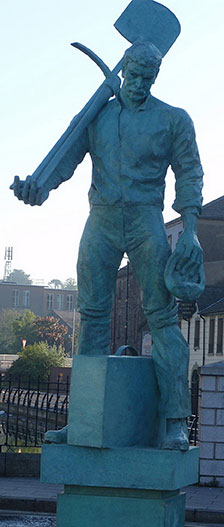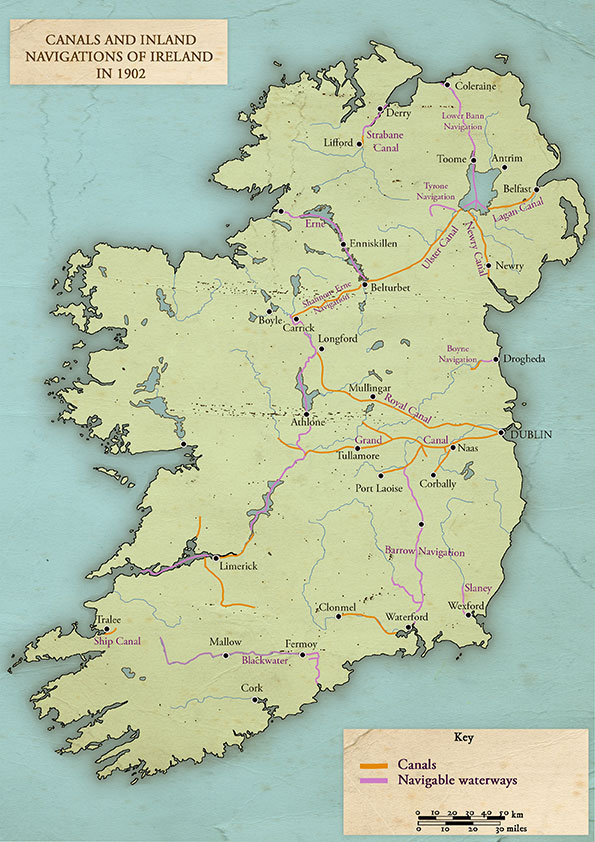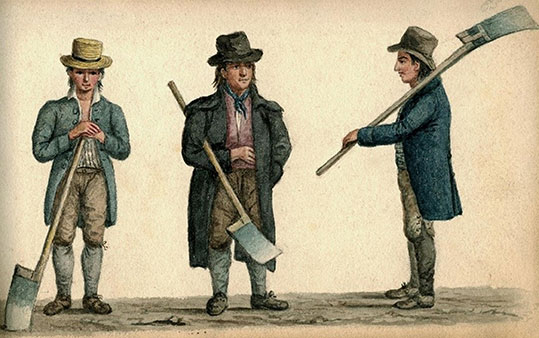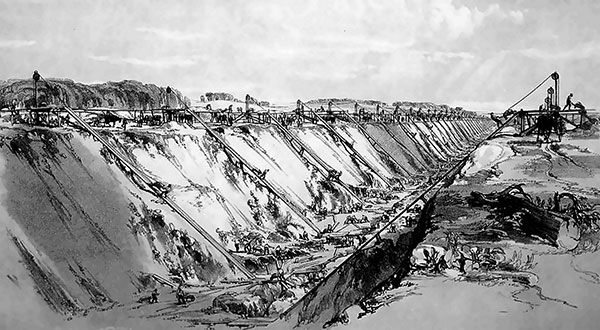By Eugene Coyle

After the Restoration, Dublin city’s rapidly expanding population was dependent on coal imports from English and Welsh collieries. English mine-owners, particularly at Whitehaven in Cumbria, controlled all Irish coal imports. The city’s demand for imported coal grew during the eighteenth century, increasing from 50,000 tons in 1700 to over 400,000 tons in the first decade of the nineteenth century.
Newry Canal
Irish coalmining began early in the seventeenth century at the Leinster Coalfield and later at Arigna, Co. Roscommon. The mines produced anthracite and lignite used in local ironworks for smelting. In 1705 good-quality bituminous coal seams, which promised high and potentially sustainable yields, were discovered west of Lough Neagh. Consequently, the mine-owners and landowners in Antrim and Tyrone lobbied the House of Commons for financial support to build an inland waterway to transport coal to Newry and then by sea to Dublin.
In 1703 the lord deputy, James Butler, the 2nd Duke of Ormonde, appointed a parliamentary committee to make financial provisions for canal-building and Irish inland navigation schemes. In 1729 the House of Commons appointed the Commissioners of Inland Navigation to oversee and finance an inland waterway from the coalfield at Lough Neagh to Newry. The canal construction began in 1731, linking the Upper Bann from outside Portadown eastwards for nineteen miles along the present-day Louth–Down border to the market town of Newry, entering the Irish Sea at Carlingford Lough. Opening in 1742, the canal took eleven years to build at a cost of £52,000 to complete.
The Newry Canal is the first example of a summit-level canal (one that rises and falls) built in Ireland or Britain. Its construction was a significant feat of canal engineering and creativity. It was dug through mountainous terrain by unskilled local tenantry using only muscle power and the spade. In March 1742, the sailing barge Cope of Lough Neagh landed at Dublin port with great pomp and ceremony to deliver the first cargo of Irish coal. It was hoped that with the delivery of Tyrone coal to Dublin Ireland would soon become self-sufficient and able to fulfil the advice of Jonathan Swift to ‘… burn everything from England, except their People and their Coals’. The Newry Canal pre-dates the Sankey Canal in north-west England by fifteen years and the Bridgewater Canal from Manchester to Runcorn on the Mersey by nearly 30 years.
The construction of the Newry Canal was a commercial success but not for the reason of its original purpose of transporting coal. The coal seams at Coalisland and Ballycastle were not economically viable and the coal supply dwindled, resulting in mine closures. Consequently, the transport of coal diminished on the canal to Dublin. Instead, the barges carried agricultural produce and general merchandise to and from Newry and Lough Neagh. Over the next century, the canal had a significant effect on the townscape and economy of Newry, transforming a small market town into a sizeable maritime port trading with the West Indies and the Americas. The economic success of the canal triggered the construction of the Coalisland, Lagan, Strabane and Ulster canals over the next century. Collectively, the canals contributed significantly to the industrialisation of Belfast, greatly facilitating the carriage of linen and, later, cotton from the surrounding countryside to Belfast port.

Grand and Royal canals
Between 1730 and 1787, the Commissioners of Inland Navigation approved upwards of £800,000 of public funds to support inland waterway projects throughout Ireland. During the 1750s, the Commissioners considered ambitious schemes to construct a central canal that would link Dublin to the Shannon. The construction of the Grand Canal began in 1755 and 30 years later it reached Robertstown in Kildare, where it forked westwards and southwards. In 1791 the southern branch reached Athy, where it joins with the River Barrow, allowing access to the sea at Waterford. The Grand Canal continued westwards to Tullamore, reaching the Shannon at Shannon Harbour, Co. Offaly, in 1804. The 127km-long Grand Canal took 48 years to build and cost £880,000.
During the 1780s, spiralling costs and frustrating delays in the construction of the Grand Canal resulted in pressure on the Irish parliament to support the building of a second canal from Dublin to the Shannon using a more north-westerly route. Despite political and economic objections as to whether the level of traffic could justify the viability of two canals, the construction of the Royal Canal began in 1790. The project encountered financial and engineering problems owing to company mismanagement and bankruptcies. Negligence and the lack of supervision resulted in several structural collapses that caused the deaths of building workers, for example at the Newcomen Bridge in Dublin and the Ryewater Aqueduct near Leixlip. The Royal Canal finally reached the Shannon in 1817 after 27 years of construction, including 47 locks, 86 bridges and four aqueducts. Its cost reached the record sum of £1.4 million.
‘Canal navigators’—‘navvies’
The construction of the canals, and later the Irish railways, required large numbers of manual workers, both men and boys, drawn from tenantry, smallholders and farm workers. The unskilled labourers working on canal construction were originally known as ‘canal navigators’, ‘excavators’, ‘diggers’ and, later, ‘navvies’. By the nineteenth century all construction workers, both skilled and unskilled, were known collectively as ‘navvies’.
After the Ulster Plantation, and for a further two and a half centuries, thousands of men, women and boys, driven by hunger and poverty, walked long distances in rural Ireland to seek manual farm work on gentry estates. ‘Hiring fairs’ were held mainly in Ulster, twice a year, in towns and villages. During the nineteenth and into the early twentieth century hiring fairs spread throughout rural Ireland. At these fairs, the most sought-after workers were those skilled in carpentry, masonry, bricklaying, the management of horses and—for women—domestic service. Farm labourers, potato-pickers and the unskilled were the last to be chosen by an employer.
Hiring fairs were used by canal and railway contractors, whose agents recruited the tradesmen and paid double or even treble wages to skilled men. This led to open competition with local landlords and gentry, and frequently resulted in violent disputes between landowners and the agents. Skilled men such as carpenters who were hired at these fairs usually remained for a full season with the canal company and became experienced, making them more eagerly sought after by Scottish and English canal and rail contractors.

As the construction of a canal—or, later, a railway—passed through a parish, large crowds of local tenantry and farm labourers gathered at the building site seeking work. Many were hired by the contractors on site and on probation. Men and boys were hired without pay for a few days to see whether they were fit enough to carry out the required tasks. Because of malnutrition, many failed to last the pace and left the site. When not digging, other functions of a navvy’s typical day included rock-blasting (using ‘black powder’), spoil-tipping, waterproofing and ballasting. Accidents were frequent and nearly always fatal, usually owing to the misfiring of explosives, collapsing embankment rockfalls and flooding.
The ‘barrow-run’
The base of the embankment was cleared by a team of up to twenty navvies, known as ‘muck-shifters’, who filled the wheelbarrows with earth and stone. A second team of navvies, known as ‘runners-out’, pushed trucks and barrows uphill, to be emptied at the top. Horses and donkeys were occasionally used to haul a full barrow and its navvy upwards to the top along slippery planks, dumping tons of rubble, while the barrow and navvy skidded back down.
Canal contractors estimated that it took up to a year to turn an inexperienced farm labourer into a navvy capable of excavating twenty tons of earth in a day. For this they were well paid—an experienced navvy earned from seven to ten shillings per week, three to five times the wage of an agricultural labourer. The navvies dug the Irish canals by hand and became skilled at moving earth and rock with a spade and pickaxe. Inexperienced navvies were paid not more than twopence per day, about a shilling a week. Those who survived the gruelling manual labour developed skills with a shovel and pickaxe and after a season often emigrated to Scotland, England or the United States.
It is a truism that it was the Irish navvy who was primarily responsible for the construction of Britain’s canal, rail and road networks during the Victorian industrial revolution. During this period, over a quarter of a million construction workers, a force bigger at that time than the British Army and Navy combined, laid down 3,000 miles of railways and 2,500 miles of inland waterways. British census returns indicate that Irish navvies made up c. 30% of navvies working in Scotland and the north of England.
Navvies were portrayed as hard-drinking and brawling men as they tramped around the countryside from building site to building site seeking work and causing mayhem and havoc. Railway navvies soon came to form a distinct group, set apart by the special nature of their work. Tramping from job to job, navvies and their families lived and worked in appallingly harsh conditions, often for years. In time, a new itinerant working-class sub-culture with a unique lifestyle evolved, with a language and behaviour of its own.

Pre-Famine peak and subsequent decline
Canal transport in Ireland reached its peak in the decade before the Famine, carrying freight, passengers, livestock and agricultural products. From the 1840s onwards, however, business on the canals declined sharply in favour of the rapidly expanding Irish railway system, which provided a more efficient means of transporting passengers, livestock and heavy goods throughout the country. The canals could not compete in terms of cost, speed or convenience. The canal companies collapsed, and the canals gradually became derelict and decayed.
In 1911, a royal commission of enquiry recommended that all Irish waterways should be placed under government and local authority control. There were by then 25 navigable or partially navigable canals in Leinster and Ulster. No action was taken on this report until after independence, when CIE assumed responsibility for the upkeep of the Royal and Grand canals. The commercial use of the canals ceased in the 1950s, however, and in 1954 the Inland Waterways Association of Ireland (IWAI) was founded by volunteers and enthusiasts to promote and encourage the use and tourist development of Ireland’s navigable waterways. In May 1960 the last cargo to be carried by a commercial barge on the Grand Canal was a consignment of Guinness stout from St James’s Harbour in Dublin to Limerick.
In 1998, under the terms of the Good Friday Agreement, an inter-governmental body, Waterways Ireland, was set up to work in partnership with the IWAI and others on a 32-county basis. In 2011, in accordance with the Good Friday Agreement, all inland waterways on the island of Ireland were brought under national ownership to be developed for environmental, tourist potential and recreational purposes.
Eugene Coyle is an independent scholar and retired tutor at the Oxford University for Continuing Education and is a Fellow of the Royal Historical Society.
Further reading
U. Cowley, The men who built Britain: a history of the Irish navvy (Dublin, 2001).
R. Delaney, Ireland’s inland waterways: celebrating 300 years (Belfast, 2004).
K.B. Nowlan (ed.), Travel and transport in Ireland (Dublin, 1993).
C. Rynne, Industrial Ireland 1750–1930: an archaeology (Cork, 2006).
